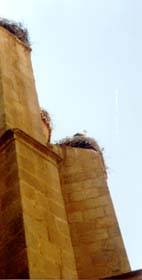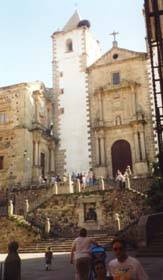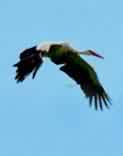|
|
|
|
| After spending several days in the beautiful, but tourist-laden Andalucia, Alex and his parents headed off the beaten track, to Extremadura, the western region of Spain that borders Portugal. On the drive from Córdoba to Cáceres, one can see distant mountains, small towns that have little more than gas stations and discos, (they always have discos!) and signs that warn of the presence of unexploded mines. Since stepping on a landmine can certainly mar a vacation, Extremadura is probably not the best place for an impromptu roadside picnic. |

|

|

|

|
|
There were as many storks in Cáceres as there were people. Those dark fuzzy blobs at the tops of each building are stork's nests. |
|||
The ancient town of Cáceres was Alex's first stop in Extremadura.
The city was built by the Romans somewhere around 100 BC,
which makes it a pretty old city.
It's a World Heritage Site, mainly because it's a pretty old city.
Is there much to do in Cáceres? Not really.
At least, not in the old part of the city, which is where the occasional
tourist is most likely to be found.
There's a city museum, which Alex enjoyed because they
had a spinning wheel, like in Disney's Sleeping Beauty,
and a big oxcart with painted wheels. It also had an old Roman flooded basement,
and who doesn't love a flooded basement?
But the real appeal of Cáceres is old buildings.
It's a rather sleepy little
For Alex, the highlight of Cáceres may have been the free apples that were available in the Parador de Turismo, a 15th Century palace converted to a hotel by the Spanish government. It was here that Alex learned to eat an apple like a big boy, in other words, by biting into a whole apple rather than having it peeled and cored. However, unlike a true big boy, he would remove the apple skin from his mouth and leave it wherever he happened to be. By the time his parents checked out of the parador, there was partially chewed apple skin everywhere. Cáceres has something else that many other towns, whether modern or ancient, lack. Cigüeñas. They have plenty of cigüeñas. In English, they're known as storks, the birds that deliver babies and Vlasic pickles. Every rooftop and tower, it seems, is adorned with stork nests, and each nest is adorned with one or two storks. None of the storks, however, appeared to be delivering babies or pickles. Alex and his parents enjoyed some Extremaduran cuisine when they dined at El Figon de Eustaquio. Alex enjoyed the espaghetti italiana, which, strictly speaking, wasn't really Extremaduran cuisine. His parents were more adventurous. They had lomo de cerdo, which, as near as they could determine, was probably filet of wild boar. (It was very tasty, by the way!) After Cáceres, our intrepid travelers headed for the nearby town of Trujillo, which may not be as historically significant, but was more fun and memorable. |
|
|
|||||||||||||||
|
|||||||||||||||
|
|||||||||||||||
Write to The Alexander Home Page
All contents copyright 1997, 1998, 1999, 2000
The Alexander Home Page,
a division of LeapToad Enterprises.



 A stork
A stork
 Another stork
Another stork
 Alex
Alex
 Alex consults his map of Cáceres.
Alex consults his map of Cáceres.